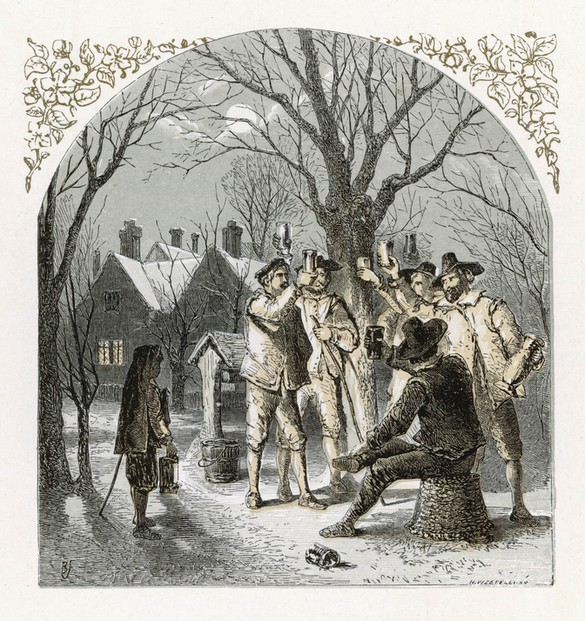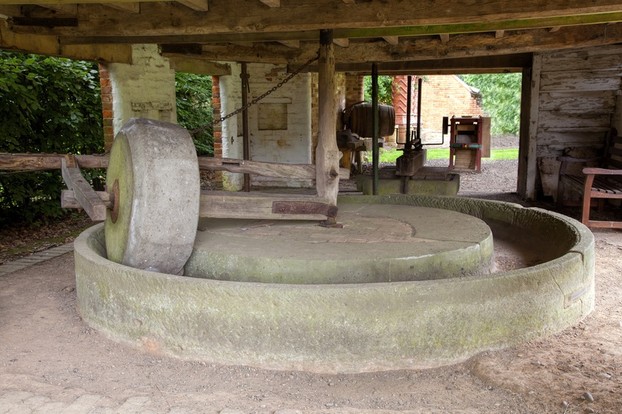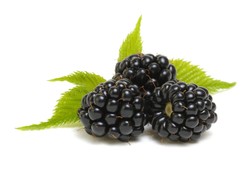In the picture below you see the ancient custom of wassailing. Some time in January, when the buds on the apple trees were becoming visible, the people of a farm would assemble in the apple orchard at night, pour a libation of cider or maybe ale onto the ground and say the incantation, which might begin
"Old Apple Tree, we wassail thee,
And hoping thou wilt bear......."
Others might call out "Wassail, drink ale! The word wassail is Anglo-Saxon and is a cry meaning "Good Health" and this ancient word shows the venerable antiquity of the ceremony. In the picture you only see men [reflecting the sexism of that period] but women were and still are equal participants in wassail ceremonies.In mediaeval farms women tended the garden while men worked the fields and the orchard, so the libation pouring was done by males most likely, but the whole family would be involved, and all drank ale or cider on that night. Furthermore, the picture shows only gentlemen, but all ranks would be included in the wassailing.Nowadays no one would be surprised to see the ceremony being led by a woman.
The custom has not fully died out, as we British being a somewhat traditional lot have a small number among us who still wassail their apple trees.They tend to be folklore enthusiasts and some pagans. I do not do it, but the tradition is a nice one, so why not keep it up? The aim was to honour the good Earth with a payment for what she gives to us.You can see the pre-Christian origins of this tradition in honouring Mother Earth.
Cider, was traditionally brewed on West Country farms, where it was an important element of farm workers' wages. The workers would be fed by the farmers by being given breakfast and maybe lunch, at which they would receive their cider ration. This meant that they got a pint of cider at breakfast and lunch. Sometimes cider would be brewed with ginger as well as yeast to make traditional ginger ale. The reformers of the Victorian period, motivated in part by puritanical ideals worked hard to suppress this custom, and to this end they developed non-alcoholic ginger ale and also encouraged farmers to give their workers tea instead. The campaigners at no point asked the workers for their opinions on the reform or indeed their consent.
The cider that they brewed was characteristically cloudy, the cloudiness coming from a slight haze that you always get in home made ciders. The modern clear cider is what the older generations called ciderkin, little cider, and it is less strong than its ancient predecessor.<>











 TheThousand Year Gardenon 11/26/2025
TheThousand Year Gardenon 11/26/2025
 Women of the Gospelson 10/11/2025
Women of the Gospelson 10/11/2025
 Religious Gardenson 08/25/2025
Religious Gardenson 08/25/2025
 Doctor of the Church: John Henry Newmanon 08/03/2025
Doctor of the Church: John Henry Newmanon 08/03/2025



Comments
Apple wood is not used for cask making, so a different kind of wood would be used.
Some Unitedstatesians avoid plastic containers for glass containers because they believe in a taste and sometimes a textural difference boring or detrimental to the former receptacle's liquid and even solid contents.
The aforementioned beliefs cause me to ponder other containers.
Cider drinks that defer to storage and do not demand immediate consumption end up in wooden vats, correct?
Might those wood vats be of the same wood as their ciders?
What happened to dispossessed nobility is unclear, but it is known that some Saxons went to Dublin, where the sons of King Harold were recruiting a resistance force. This invaded England twice, but was beaten. Some nobles joined the unsuccessful rebellion of Edgar the Atheling. A long-standing pathway for Saxons was to migrate to Constantinople to join the Varangian Guard, a force belonging to the Byzantine emperor. But when the Normans of the fourth crusade took Constantinople in 1205 they did their English Normans a favour by massacring the [anti-Norman] Varangians. Any dispossessed nobles lost their titles.
I know the book of which you speak, but do not deem it particularly informative.
Re-visiting your wizzley called to mind what I meant to ask you after your helpful answer 02/08/2018 to my question 02/07/2018.
We discussed nobility losing lands with the outcome of 1066 (By the way, do you know the little book 1066 and All That?). What happens to dispossessed nobles? Would they become homeless? Would they lose their titles also?
I am unfamiliar with the American term hard cider. We in the UK speak of sweet and dry cider, the dry being cider with more sugar brewed out of it. But thank you, it is good to know the various variations of the English language.
I love apple cider that has not been pasteurized when it is available in the fall (in the U.S.) I've also had some good hard cider. I don't drink alcohol much and mostly red wine. I think I'll look for some hard cider the next time I go shopping.
The raw steak has been abandoned.
Much of English life remained unchanged by the conquest,and daily customs carried on. After all, one bunch of exploitative nobles was exchanged for another.The statement that less than ten percent of nobility kept their lands surprises me, as I think ten percent a bit high. I know that on the English border with Scotland Anglo-Saxon nobility survived as they were needed to fight the Scots, and some stayed on in Herefordshire on the Welsh borders, but the rest were mainly dispossessed.There were definitely still Saxon landowners in the time of King John in the early thirteenth century.
The Normans loved cider and as they imported the pear to England they introduced perry. Normandy produces great ciders. So they had a vested interest in preserving cider brewing traditions
FrankBeswick, Thank you for the cider-making tour. Have craft-minded cider-makers today included the raw steak? Your mention of persistent Anglo-Saxon and Briton customs made me think, in another direction, of 1066, the Domesday Book. New Anglia and the coming of the King's Cloth, Queen Matilda's Tapestry, the Bayeux Tapestry to England. Did these customs persist among the pre-Norman people that the Normans didn't perceive as problematic or in need of being "Normanized"? A Yale professor says that 1066 resulted in less than 10 percent of nobles keeping their properties.
Glad to have told you something new.
I had not heard of an apple crusher before. Again, I have learned something.